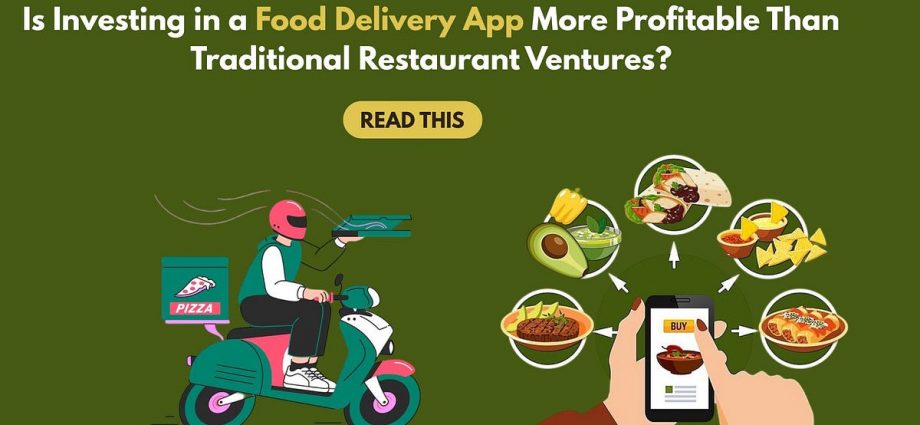The rise of food delivery apps has disrupted traditional restaurant business models, making investors and entrepreneurs rethink their strategies. With shifting consumer preferences, technological advancements, and increasing demand for convenience, investing in a food delivery app may offer better returns than opening a traditional restaurant. But is this truly the case? Let’s dive deep into the prospects and challenges of both investment opportunities.
In recent years, the meal delivery industry has experienced exponential expansion. With people leading busy lifestyles, the demand for ordering food online has skyrocketed. Studies indicate that the global food delivery market is expected to reach hundreds of billions of dollars within the next decade. As smartphone penetration increases and internet accessibility expands, more consumers are opting for food delivery services over dining out.
A food delivery app development company plays a crucial role in creating scalable and efficient platforms that connect restaurants with consumers. These apps provide convenience, variety, and accessibility, making them a preferred choice for urban and suburban customers alike. Unlike traditional restaurants, food delivery platforms can cater to a wider audience without the need for expensive real estate or large operational costs.
One of the biggest challenges of starting a traditional restaurant is the high initial investment. From renting a prime location and renovating the space to hiring staff and managing inventory, the costs add up quickly. Additionally, restaurant owners must deal with unpredictable operational expenses, including utilities, maintenance, and compliance with health regulations.
In contrast, investing in a food delivery app requires significantly lower startup costs. A well-developed app eliminates the need for physical infrastructure, reducing real estate and labor costs. By working with a food delivery app development company, entrepreneurs can start a customized platform that integrates advanced ordering systems, payment gateways, and real-time tracking features. This not only cuts down operational expenses but also enhances the overall customer experience.
Traditional restaurants have limitations when it comes to expansion. Scaling a restaurant business requires opening multiple locations, which involves significant capital investment and logistical challenges. Even if a restaurant builds a strong brand, the process of expanding to new cities or regions can take years.
Food delivery apps, on the other hand, are highly scalable. Once the platform is developed, it can be expanded to different markets with minimal investment. The ability to onboard multiple restaurants, offer diverse cuisines, and partner with local delivery providers allows food delivery businesses to grow at a much faster rate than traditional restaurants. Additionally, data analytics tools enable app owners to identify customer preferences, optimize delivery routes, and implement dynamic pricing models to maximize profits.
Restaurants typically operate on thin profit margins due to high overhead costs, fluctuating ingredient prices, and employee wages. Even with a steady stream of customers, traditional restaurants may struggle to maintain consistent profitability.
A food delivery app offers multiple revenue streams, making it a more attractive investment. These include:
- Commission from Restaurants: Apps charge partner restaurants a percentage of each order placed through the platform.
- Delivery Fees: Customers pay service and delivery fees, which contribute to the app’s revenue.
- Subscription Models: Many apps offer premium memberships that provide users with benefits like free delivery and exclusive discounts.
- Advertising Revenue: Restaurants can pay for promotional placements within the app to increase visibility and attract more orders.
By monetizing various aspects of the service, food delivery platforms can achieve higher profit margins than traditional restaurant businesses.
It’s well known that the restaurant business fails a lot. Studies suggest that a significant percentage of new restaurants fail within their first few years due to poor location choice, high operational costs, or changing consumer preferences. Restaurant owners also have to deal with unexpected challenges like economic downturns, seasonal fluctuations, and global crises.
Food delivery apps provide a more flexible business model that mitigates these risks. Since they operate digitally, they are less affected by location constraints or in-person dining trends. Additionally, delivery platforms can quickly adapt to market demands by introducing new features, offering promotions, or expanding their services to include groceries and convenience items. By partnering with a food delivery app development company, investors can create a versatile platform that remains relevant in the ever-changing food industry.
While the potential for high returns is evident, food delivery apps are not without challenges. The market is becoming increasingly competitive, with established players dominating the space. To stand out, new entrants must invest in innovative technology, strategic marketing, and strong partnerships with local restaurants and delivery personnel.
Customer retention is another challenge. Many consumers use multiple apps and switch between platforms based on discounts and promotions. Therefore, ensuring a smooth user experience, reliable delivery services, and competitive pricing is essential for long-term success.
Both food delivery apps and traditional restaurants offer unique investment opportunities. However, for investors and entrepreneurs looking for scalable, low-risk, and high-return ventures, food delivery apps present a more promising avenue. The lower initial investment, multiple revenue streams, and growing demand for online food ordering make them an attractive choice in the current market landscape.
For those considering this business, working with a food delivery app development company is crucial in ensuring a successful and efficient platform. With the right technology, marketing strategy, and customer engagement tactics, a well-developed food delivery app has the potential to outperform traditional restaurant ventures in terms of profitability and sustainability.
The future of the food industry is shifting toward digital platforms, and investing in a food delivery app can be a game-changing move for those looking to capitalize on this trend. While traditional restaurants will always have their place, the scalability and revenue potential of food delivery platforms make them a more attractive investment option in today’s fast-paced digital world. Investors and entrepreneurs willing to embrace innovation and invest in a well-structured food delivery app are likely to reap significant rewards in the years to come.


